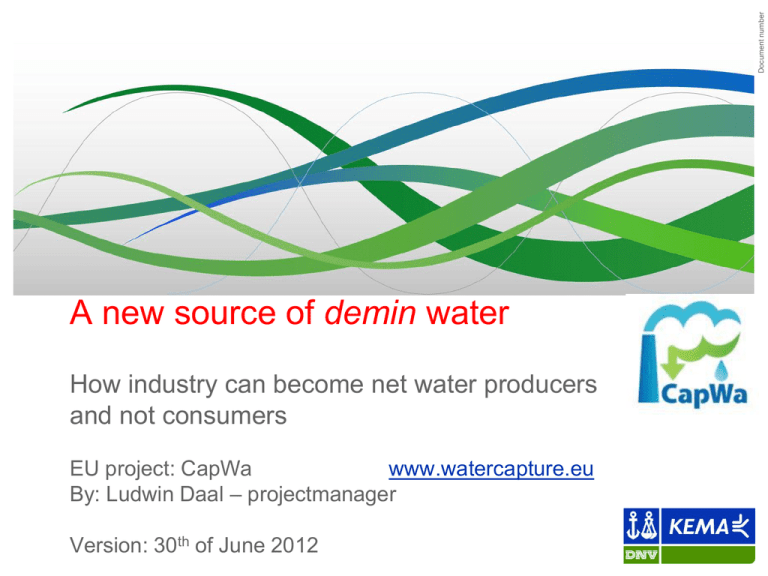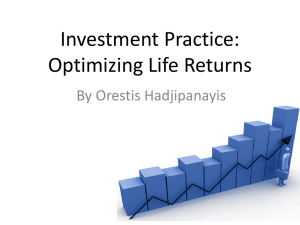Ludwin Daal: A new source of water
advertisement

Document number A new source of demin water How industry can become net water producers and not consumers EU project: CapWa www.watercapture.eu By: Ludwin Daal – projectmanager Version: 30th of June 2012 Content – a new source of demin water What does the technology enable Working principle Technology development path EU funded CapWa project - First prototype Results energy calculation Economical comparison Benefits technology EU succes story – global media attention What does this technology enable? – Example China 1.There is an actual 600 MWe Coal fired power plant which can now operate additional profit EUR 14 MLN yearly(1) Corresponds to demin water(1) value: 162 EUR/m3 2. Expansion or New Build in WET or DRY region: Saving by placing plant in DRY region (on top of coal): EUR 3-5 MLN yearly versus coal transport to WET regions True value demin water 18 EUR/m3 congestion of rail infrastructure can result in higher value Amount of plants with these issues are increasing worldwide due to stringent regulations and water shortages (1) Assuming 4500 lost operation hours, a water need of 37 m3/hr and a loss margin of EUR 10 per MWh (profit & effective use of CAPEX) What does the technology enable? Ex. Algae bloom Red Tide – algae bloom causes desal plant shut down - Temporarily no water available for power plant - Growing risk i.e. Australia & Middle East - Occurrence Gulf of Oman about 1x a year YES power plant shut downs occurred here Implications 380 MWe Gas fired power plant Loss of income + penalties ±EUR 850.000 per day! True value demin water(1): 82 EUR/m3 Industry accepts worst case – water truck: 10 EUR/m3 Is equivalent to a plant shut due to Red Tide, once every 10 years.... (1) Assuming 8000 hours operation, E-price of EUR 50 per MWh and demin water need of 1 m3/hr Working principle H2O Special Coating Vacuum Flue gas H2O N2 NOx O2 N2 CO2 NOx SO2 O2 H2O Vacuum & Condenser CO2 SO2 H2O P = 1atm Hollow membrane fibre Micro scale Macro scale Membrane materials: visually 500 m 1 m Micrometer-scale selective material coated on porous support fibre Principle water capture Emits 150 m3 water per hour to the atmosphere Needs 30 m3/h water 20% capture 90-120 m3 water per hour Furnace No FGD in place: ESP Flue gas Desulphurization 400 MW coal fired power plant with FGD: Membranes Equiv. Gas Fired plant: Emits 90 - 120 m3 water per hour Needs about 1 m3/h water 12 year preliminary research Background: - Power companies expected doubling of water tariff in the ’90’s - Surface water needed extensive water treatment steps - Research by KEMA, University of Twente & Dutch Power industry Field tests – flue gas Relative humidity Duration Results (1) 2 95-99% 32 weeks 0.2 L/m /h Coal fired power plant Overview of general technology development: after reheat max. 60 °C 500 – 1000 S/cm Year 2003 Coal fired power plant after FGD 46 -48 °C 100% >5000 hours 1.4 L/m2/h 20 S/cm 2006 Waste to Energy max. 65 °C 100% 1 year 3-4 L/m2/h 40 S/cm; 2007 Gas burner at 40-50 °C 70% 20 hours ~1 L/m2/h 2009 Gas burner at 80-90 °C 10% 100 hours ~0.03 L/m2/h 2010 >40% water capture, results warrent a follow up! (1) water flux in litre liquid water per m2 membrane area per hour; water purity in specific conductivity Field test Waste to Energy plant Setup permeate recovery Fouling after 10 months before CIP Gypsum particles Cleaning in place units placed Goal / ambition of EU project: Capture of evaporated water - CapWa produce a commercially available membrane modular system suitable for industrial applications within 3-4 years. The produced demin water from this system should be competitive with existing demin water technologies. The starting point will be the water vapour selective composite membranes that are developed in the proof of principle project. Applicability Power generation – flue gases - Coal-fired power plants - Gas-fired power plants - Waste to energy plants Industrial processes - Paper mills; wood drying & similar drying processes Petrochemical plants; offshore Cement factories Glass production … under investigation cooling towers Prototype membrane module installed at Sappi Nijmegen end 2011 CapWa – aim demonstrations Aim EU funded international project (9 EU & 3 African partners): Automation of hollow fibre membrane production – milestone reached! Construct a module system for flue gases (coal and gas fired plants) - the system is capable of producing 0.1 m3/h water - roughly the size of a 22 ft container – based on a curtain shaped 1 stage separation system A smaller system is envisaged for: - (forced draft wet) cooling tower with Tunisian geothermal well - under the hood of a paper/board factory Outcome energy modelling DNV-KEMA utilized process modelling Software SPENCE® KCPK utilized inhouse modelling tool (& PTS) Both models use actual (field)data Calculations optimized and reviewed Preliminary results validation needed Overall energy improvement - COAL fired plants with cooling water: 0.2% - Paper mill – with heat exchangers: 6% - Paper mill – optimized with capture tech.: >15% 16 Capture technology versus traditional demin technologies – basis 400 MW CF PP in Wet Region + Polishing Pre-treatment + Tap water Tap water process Extraction Demin Seawater Freshwater Discharge + = Captured Evaporated water Evaporated water + Overall pure water cost Polishing 2,5 Be aware: low membrane price of 20-50 EUR/m2 used comparible with RO. However total cost does not include benefits like: EUR per m3 2 1,5 o flexibility - transport 1 o corrosion mitigation 0,5 o energy 0 MSF MED RO IX Commercial tender CapWa Benefits of this technology Technology aims to be competitive with current demin water production At least five business cases identified for end users: - Water: availability and raw water source quality - Energy: at least 0.2% for CF PP with cooling water - Corrosion mitigation: reduction of water condensation in stack - Sustainability(1): Large social impact in dry regions preservation and conservation of natural resources - plant flexibility: ability to locate plant or enlarge existing asset in dry area’s & save on transport without extra water consumption; no shut-downs due to recurring environmental catastrophes like algae bloom the membranes used to capture water also capture CO2 (www.NanoGLOWA.com) (1) Global media attention www.watercapture.eu or also http://ec.europa.eu/research/industrial_technologies/success-stories_en.html 13 Dutch Regional Newspapers International websites Populair technical publications Feedback in China – July/Aug 2011 Over 50 websites - Incl. top 8 media - 4 published Document number Thank you for your attention Ludwin.Daal@DNVKEMA.com


